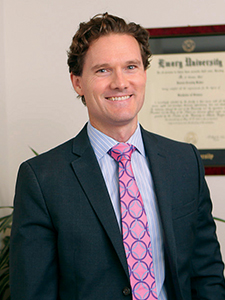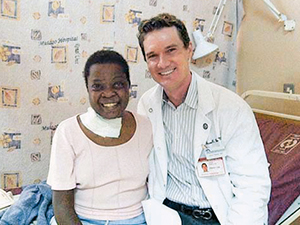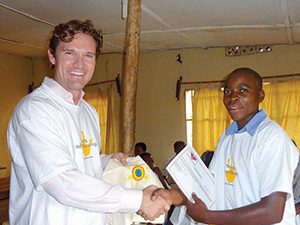Type 1 Diabetes: It’s Professional and Very Personal

Dr. Jason C. Baker
When Jason C. Baker, MD, was in his last year of medical school he journeyed to Ghana for a six-week radiology project, bringing first-class, state-of-the-art equipment and deepening skills, ready to deliver care and get to know a patient population in a completely different environment. The previous year, as a 25-year-old, third-year medical student at Emory School of Medicine, Dr. Baker discovered he had type 1 diabetes. He found, in Ghana’s environment, he had to be startlingly vigilant, husbanding his medical supplies and carefully sifting dietary resources, knowing, throughout the trip, he would in due time be on a plane going home to easy access to resources.
“What if I lived here full-time? What if I were Ghanaian?” Dr. Baker remembers thinking. “It was a huge learning curve to manage myself in Ghana. It planted seeds. What would happen to me in an environment where air conditioning, refrigeration, and maintaining a nutritional diet are so challenging?”
That same year, in September 2001, a second event imprinted itself on his career. “While helping to run the morgue at Ground Zero, I remember excusing myself and going over to a burned-out corner to check my blood sugar,” says Dr. Baker. “I realized that even in the most extraordinary and unorthodox situations, I couldn’t ignore my type 1 diabetes otherwise it would conquer me.” The thought stirred him and, today as an attending endocrinologist with NewYork-Presbyterian/Weill Cornell Medical Center, he maintains a professionally focused empathy for individuals with type 1 diabetes who, in particular, are trying to manage their disease in unusual or challenging circumstances.


Dr. Jason Baker with the late Marjorie Namayanja and with a student on graduation day for a diabetes education program in Rwanda
A Global Cause
In 2010, Dr. Baker met Marjorie Namayanja, a Ugandan, at an international educational symposium on type 1 diabetes (T1D) for healthcare providers. Ms. Namayanja had been diagnosed with T1D at age three. At 27 years old, she had long outlived almost all who receive such a diagnosis in developing countries and had already begun dialysis. She had spent most of her life advocating to bring sufficient modern supplies and education about type 1 diabetes to Uganda, where here and in other developing countries, glucose strips and sufficient insulin are generally unavailable. Two years after their first meeting, Ms. Namayanja died awaiting a kidney transplant.
“I have no doubt in my mind that had she been in the United States, her diabetes would have been better controlled, and if she developed kidney issues at some point, she would have received a transplant and be alive today,” Dr. Baker says. “In that area of the world, when you develop a complication like she did, it’s a death sentence. We have so many resources available to us in this country, but the developing countries of the world are really struggling with access to care. And we still have communities in the United States that don’t have adequate access.”
In 2011, Dr. Baker founded Marjorie’s Fund; its stated mission is “to empower adolescents and adults living with type 1 diabetes in resource-poor settings to not only survive, but to effectively manage their diabetes and survive.” Run almost entirely by volunteers through donations and small grants, Marjorie’s Fund is currently in Rwanda, Uganda, Gambia, Ethiopia, India, and New York City.
In Rwanda, Marjorie Fund’s Education Center works with a local diabetes association to create comprehensive education programs for adolescents and young adults. “We’re not interested in going in with just goodwill and supplies,” notes Dr. Baker. “Students in the Rwandan program get insulin and glucose testing strips, accompanied by lessons in diabetes management and nutrition.” The Rwandan Diabetes Education Center also offers vocational training in sewing, baking, hairdressing, and more. Each participant leaves the Education Center with a new understanding and skill in managing his or her type 1 diabetes, and with vocational training, which enables them to find work that will, in turn, help them afford T1D supplies and nutritious food.
Dr. Baker spends approximately 30 percent of his time administering Marjorie’s Fund, traveling to its various sites on a regular basis. He and his Fund colleagues reach out to government officials, patient advocacy groups, and NGOs trying to create, in Dr. Baker’s words, “a much more sustainable approach.”
The Treatment Challenge
“Diabetes is an evolving field,” acknowledges Dr. Baker, who also maintains a busy practice and teaching schedule at Weill Cornell. “It is on the rise and has become a huge issue in every nation. It’s not as simple as type 1 versus type 2. You can have an obese type 1 or a thin type 2. There are many different ‘flavors’ of diabetes: maturity-onset diabetes of the young, latent autoimmune diabetes in adults, and gestational. Malnutrition diabetes can diagnostically look like type 1 diabetes mellitus, leading to dangerously incorrect treatment. There is no algorithm that we as clinicians can follow in terms of saying, ‘This is the right step. After this step we have the next step and the step after that.’ Treatment has to be individualized in terms of choosing the medications, but also in providing the patient with the right type of lifestyle advice.” Dr. Baker himself wears a continuous glucose monitor, which he shows to patients in order to demonstrate that, even with his level of expertise, his blood sugar can go too high.
Determining the right medication is particularly complex. “There are approaches that work for some people, but not for others,” notes Dr. Baker. “For example, many medications, while they lower glucose, promote weight gain in patients who already have issues with weight and contribute to a worsening of control. Some medications can precipitate beta cell burnout. Used in the setting of those who may have poor beta cell reserves to begin with, the medications could ultimately destroy their ability to make insulin. The more we can minimize adverse effects of medications and identify alternatives, the better our patients’ outcomes will be. The take-home is that we have a lot of treatment options, but we have to do our best to explore those options before we consider the treatment regimen stable and the right one for that patient.”
Related Publications





